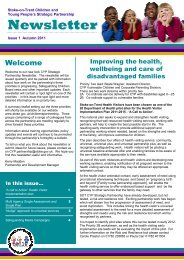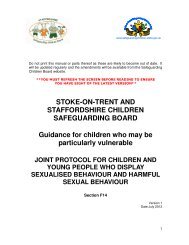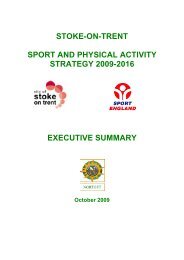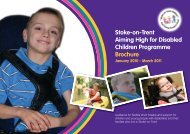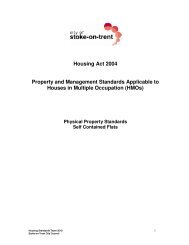Director of Public Health Annual Report 2012 [pdf] - Stoke-on-Trent ...
Director of Public Health Annual Report 2012 [pdf] - Stoke-on-Trent ...
Director of Public Health Annual Report 2012 [pdf] - Stoke-on-Trent ...
You also want an ePaper? Increase the reach of your titles
YUMPU automatically turns print PDFs into web optimized ePapers that Google loves.
The percentage <str<strong>on</strong>g>of</str<strong>on</strong>g> adults (aged 16 and over) who had quit smoking at four weeks in NHS<br />
<str<strong>on</strong>g>Stoke</str<strong>on</strong>g>-<strong>on</strong>-<strong>Trent</strong> in 2011/<str<strong>on</strong>g>2012</str<strong>on</strong>g> was 50.1% (compared with 49.1% in England). This means<br />
that <str<strong>on</strong>g>of</str<strong>on</strong>g> the 6,477 local people who set a four week quit date, 3,248 had quit smoking at four<br />
weeks, which is the highest number <str<strong>on</strong>g>of</str<strong>on</strong>g> quitters in NHS <str<strong>on</strong>g>Stoke</str<strong>on</strong>g>-<strong>on</strong>-<strong>Trent</strong> since 2005/2006. It is<br />
also the first time that over 50% <str<strong>on</strong>g>of</str<strong>on</strong>g> local people who set a quit date had quit smoking at four<br />
weeks, and it is also the first time that the percentage <str<strong>on</strong>g>of</str<strong>on</strong>g> quitters in NHS <str<strong>on</strong>g>Stoke</str<strong>on</strong>g>-<strong>on</strong>-<strong>Trent</strong> is<br />
higher than the percentage in England.<br />
Smoking in the home<br />
Around 27% <str<strong>on</strong>g>of</str<strong>on</strong>g> young people in <str<strong>on</strong>g>Stoke</str<strong>on</strong>g>-<strong>on</strong>-<strong>Trent</strong> are exposed to sec<strong>on</strong>d hand smoke in their<br />
own homes, and nearly 50% in the car. Exposure to sec<strong>on</strong>d hand smoke can lead to<br />
respiratory illness, glue ear and worsened asthma as well c<strong>on</strong>tributing to sleep disturbance<br />
and behavioural problems. Children living with a smoker are also three times more likely to<br />
take up smoking themselves. Therefore, while quitting smoking is always promoted as the<br />
'gold standard', if parents and carers do not feel ready or able to quit, they are provided with<br />
informati<strong>on</strong> and support to make their homes smoke-free.<br />
Smoking and young people<br />
Around 8% <str<strong>on</strong>g>of</str<strong>on</strong>g> 11-16 year olds in <str<strong>on</strong>g>Stoke</str<strong>on</strong>g>-<strong>on</strong>-<strong>Trent</strong> are ‘regular smokers’ compared with 5%<br />
nati<strong>on</strong>ally. Nearly 50% <str<strong>on</strong>g>of</str<strong>on</strong>g> young people have tried smoking, and the majority have d<strong>on</strong>e so<br />
before the age <str<strong>on</strong>g>of</str<strong>on</strong>g> 15. The younger the age <str<strong>on</strong>g>of</str<strong>on</strong>g> uptake <str<strong>on</strong>g>of</str<strong>on</strong>g> smoking, the greater the harm is<br />
likely to be because this is associated with subsequent heavier smoking, higher levels <str<strong>on</strong>g>of</str<strong>on</strong>g><br />
dependency, a lower chance <str<strong>on</strong>g>of</str<strong>on</strong>g> quitting, and higher mortality. Child and adolescent smoking<br />
causes serious risks to respiratory health both in the short and l<strong>on</strong>g-term. Children who<br />
smoke are two to six times more susceptible to coughs and increased phlegm, wheeziness<br />
and shortness <str<strong>on</strong>g>of</str<strong>on</strong>g> breath than those who do not smoke 5 .<br />
In 2009, 16% <str<strong>on</strong>g>of</str<strong>on</strong>g> 11-16 year olds said they “didn’t remember” any less<strong>on</strong>s <strong>on</strong> smoking, drug<br />
use and alcohol in school. Since then two Drug, Alcohol and Tobacco Advisors have been in<br />
place to develop up-to-date, effective educati<strong>on</strong>al materials and training to support schools<br />
to deliver tobacco preventi<strong>on</strong> systematically across the curriculum. In additi<strong>on</strong> to this, an<br />
evidence-based peer-support programme has been commissi<strong>on</strong>ed which has been shown to<br />
reduce significantly the rate <str<strong>on</strong>g>of</str<strong>on</strong>g> smoking am<strong>on</strong>gst young people.<br />
Smoking during pregnancy<br />
Smoking during pregnancy harms an unborn baby and will <str<strong>on</strong>g>of</str<strong>on</strong>g>ten result in both short and<br />
l<strong>on</strong>g-term health problems for children. Smoking during pregnancy increases the risks <str<strong>on</strong>g>of</str<strong>on</strong>g><br />
miscarriage, the baby being stillborn, having a<br />
low birth weight, being at increased risk <str<strong>on</strong>g>of</str<strong>on</strong>g> cot<br />
death and having an increased risk <str<strong>on</strong>g>of</str<strong>on</strong>g> respiratory<br />
Smoking during pregnancy harms an<br />
unborn baby<br />
disease. Smoking during pregnancy is also a major c<strong>on</strong>tributor to higher infant mortality<br />
rates am<strong>on</strong>g families from routine and manual socioec<strong>on</strong>omic groups. Encouraging<br />
expectant mothers (and fathers) to stop smoking around the time <str<strong>on</strong>g>of</str<strong>on</strong>g> c<strong>on</strong>cepti<strong>on</strong>, during and<br />
after pregnancy, remains a top public health priority.<br />
28 | P a g e


![Director of Public Health Annual Report 2012 [pdf] - Stoke-on-Trent ...](https://img.yumpu.com/32721490/30/500x640/director-of-public-health-annual-report-2012-pdf-stoke-on-trent-.jpg)
